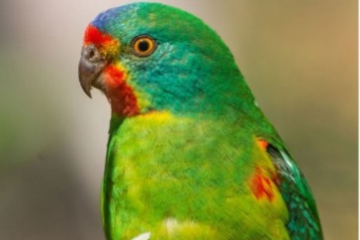General comment
- A healthy bird community removes between 50 and 70% of leaf-feeding insects from farm trees.
- 430 bird species were recorded over 2 years on 330 farms in southern and eastern Australia. The average size of the farms was 608 ha.
On tree cover
- For every 10% increase in tree cover, bird diversity increased by 7%. At the some time exotic birds decreased by 21%. Where more than 80% of the farm trees were local native species, the diversity of woodland-dependent birds was 43% greater.
Local conditions
- Woodland-dependent birds were 8% more diverse in farm sites where at least 2 different tree were present. In such sites, honeyeaters were 9% and fruit-eaters 7% more diverse.
- Woodland-dependent birds were 21% more diverse in farm sites where trees had regenerated naturally compared with sites where trees had been planted
- Small foliage-gleaning birds were 26% less diverse in farm sites where exotic trees had been planted instead of native trees. By contrast, exotic birds were about 5 times more diverse in these sites
Land use impacts
- Bird diversity of ground-foraging birds was lower in sites to which fertiliser had been applied in the past 5 years. Diversity was less where ploughing had occurred over at least 25% of the area (especially with ground-nesters and understorey birds).
- More then 50% of the declining bird species in temperate Australia forage at least partly on the ground and depend to some extent on native pasture.
- Bird diversity is re-established about 15 years after the removal of stock from a heavily grazed site. This increase in diversity continues, reaching a maximum after about 25 years.
- Ground foraging birds were 16% more diverse in sites with native pasture. Diversity was lowest where fertiliser had been applied.
- Understorey birds were most diverse in farm sites that were never grazed. Total bird diversity decreased by 25% in sites where much of the ground cover was removed.
Patch and corridor Sizes
- Bird diversity declined in woodland patches smaller than 10 hectares.
- Woodland-dependent birds were 31% more diverse in farm sites surrounded by other woodland. Exotic birds were 51% more diverse in isolated farm sites.
- Woodland-dependent birds were 12% more diverse in broad strips of native vegetation. compared with narrow strips (less than 50 m wide). Ground-foraging birds were 12% more diverse in these broad strips
Tree age range
- Bird diversity increased by 30% for every 10 large trees present. Diversity of hollow-nesting birds increased by 20% for every 10 large trees present.
- A critical age for planted trees appears to be between 5 to 10 years, after which bird diversity is significantly greater.
- The critical tree age for woodland-dependent ground-foragers was around 35 years.
On fallen trees
- For every 10 fallen trees present, the diversity of ground-foraging birds increased by 30% and bark foraging birds by 70%. Total bird diversity was greater in farm sites with leaf litter, particularly the litter was in dense clumps.
On shrub cover
- Where understory shrubs were present. there was a 31% increase in woodland-dependent birds. Small foliage-gleaners increased by 24%. Ground-nesting birds were almost 3 times as diverse.
On vegetation around water
- A river or creekline frontage resulted in a 21% increase in diversity of woodland-dependent birds. Diversity increased by 3% with each additional farm dam.
- Small birds were 28% more diverse and ground-nesters were 29% more diverse when waterways were present. For every 10m increase in distance to the nearest permanent water source, there was a 10% decrease in waterbird diversity and a 5% decrease in diversity of ground-nesting birds.
- There was a 14% increase in waterbird diversity if dense shrubby vegetation, shallow areas, islands or dead trees for roosting or stock-excluding fences were added. The presence of 2 such features resulted in a 28% increase and 3 features resulted in a 42% increase.
Dr Geoff Barrett
Birds Australia have been conducting a Birds on Farms Survey since 1995. A more extensive summary is available from the Birds Australia national office Phone 03 9882 2622.


Leave A Comment